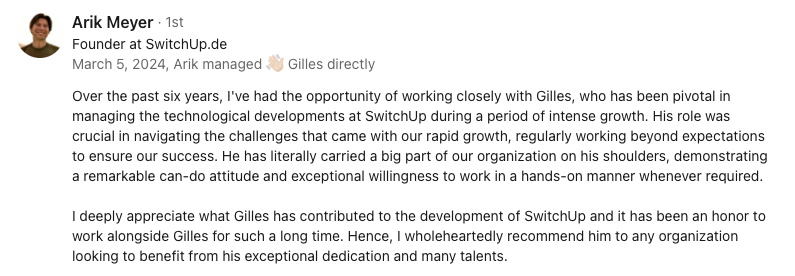Abstract:
The article emphasizes the strategic importance of cloud-based solutions for disaster recovery in startups, highlighting how these technologies offer a cost-effective, scalable, and flexible approach to safeguarding data and ensuring business continuity. It details the practical benefits such as reducing downtime, enabling geographic redundancy, and supporting remote work, which are crucial for startups operating on limited budgets. The article draws on personal experiences and examples, such as a tech executive's account of a seamless recovery from a server failure, to illustrate the effectiveness of cloud solutions. It also discusses the importance of selecting the right cloud service provider, considering factors like Recovery Point and Time Objectives, security, compliance with regulations like GDPR, and transparent pricing. Additionally, it underscores the role of remote work in disaster recovery, highlighting tools like Slack and Google Workspace as essential for maintaining productivity. The piece further explores cost-effective strategies, like using free cloud services and open-source tools, and shares case studies of successful implementations by companies like N26 and Wise. The article concludes by stressing continuous improvement through regular testing and fostering a culture of learning and adaptability, which are vital for startups to remain resilient in a fast-paced technological landscape.
Navigating startup life can be tricky. For many new businesses, the threat of data loss or service disruption is a real worry. That's where cloud-based solutions come in, offering not only a way to survive but to thrive. Imagine knowing your data is safe and you can quickly recover from unexpected problems. This article will look at how cloud technologies can turn disaster recovery into a strategic advantage for startups. We'll explore the practical benefits like cost savings and flexibility that make cloud solutions essential for any startup aiming to succeed.
Cloud-based solutions for disaster recovery
Startups face many challenges, from scaling quickly to keeping services available. One major concern is disaster recovery. Cloud technologies offer a promising solution, providing tools to recover from disruptions and strengthen resilience.
Benefits of cloud-based disaster recovery
Cloud-based recovery solutions offer significant advantages, especially for startups on tight budgets. They provide cost-effectiveness and scalability, allowing businesses to recover from disruptions without heavy spending on infrastructure. Startups can adjust resources as needed, which helps manage finances better.
In my experience as a tech executive, I've seen how cloud solutions save time and resources for startups. For example, during a server failure at a startup I consulted for, our cloud recovery plan worked seamlessly. What could have been a major issue was just a minor hiccup, thanks to the scalable cloud services. Being able to recover quickly from disruptions is often the difference between success and failure for startups, making cloud solutions invaluable.
Cloud recovery solutions also significantly reduce downtime. For startups with limited funds, minimizing downtime is crucial to keep customers happy and maintain business continuity. This is especially important in industries where even a few minutes of downtime can mean big revenue losses. I've seen firsthand the urgency and financial impact downtime can create. Keeping services operational during and after a disruption is vital for startups trying to make their mark in competitive markets.
Cloud solutions also offer geographic redundancy, ensuring data availability even if one location is compromised. This is crucial for maintaining data integrity and continuity. During my time as a CTO, I learned the importance of geographic redundancy when a local data center went down. Thankfully, our operations were unaffected because of our strategic cloud backup systems. Geographic diversity in cloud operations is essential for strong disaster recovery strategies.
Selecting the right cloud service provider
Choosing the right cloud service provider for disaster recovery is crucial for safeguarding operations. Start by considering Recovery Point Objective (RPO) and Recovery Time Objective (RTO). These metrics determine how quickly a business can recover data and resume operations after a disruption. Aligning these capabilities with operational needs means startups can confidently meet customer expectations even in worst-case scenarios.
Security and compliance are also critical factors. Providers must adhere to standards like GDPR and have strong security measures to protect sensitive data. Working across Europe, I've seen how non-negotiable compliance is, especially with regulations like GDPR. Choosing a provider with a solid track record in data security can greatly protect a company's reputation and resources.
Understanding the provider's pricing models is key for budget management. Transparent pricing helps avoid unexpected costs, which is vital for financial planning and operational efficiency. Managing budgets in Berlin, clear pricing models were essential for accurate forecasting and ensuring every euro was spent wisely. This allowed us to allocate resources to other critical areas and ensure sustainable growth.
For startups, using cloud technologies for disaster recovery is a strategic move. By understanding the benefits and choosing the right providers, startups can withstand disruptions and thrive in their markets.
Integrating remote work in recovery planning
The shift to remote work is now a key part of disaster recovery strategies for startups. By allowing teams to work without needing an office, remote work offers flexibility that's invaluable during crises. This adaptability ensures businesses can continue even when normal workflows are disrupted.
Role of remote work in disaster recovery
Remote work lets startups handle disruptions by not relying on physical offices. This was clear during the COVID-19 pandemic, where companies like N26 and Revolut used cloud infrastructures to keep running smoothly. Collaboration tools are crucial here, helping with communication and productivity. Living in Lisbon, I've learned to fully embrace remote work, making my operations more flexible and resilient. This flexibility is not just a convenience but a strategic asset for business continuity.
Tools that support collaboration and communication are key to successful remote work. Platforms like Slack, Google Workspace, and Microsoft Teams keep teams connected and productive, no matter where they are. When I transitioned to remote work in Berlin, I found Slack indispensable for keeping my team cohesive. These tools are not just extras; they are essential for maintaining efficiency during remote work.
Ensuring remote work readiness
To include remote work in disaster recovery plans, startups must ensure their workforce and IT systems are ready for remote operations. Secure access protocols like VPNs and Multi-Factor Authentication (MFA) are crucial for data protection when employees work from different locations. Regular drills enhance readiness, allowing teams to practice and refine security measures. According to guidelines from NIST and OWASP, these steps are foundational for securing remote operations and defending against cyber threats.
Regular drills and training sessions help employees adapt to remote work and identify gaps in recovery plans. Through these practices, staff become familiar with remote operations, ensuring preparedness and uncovering strategy weaknesses. In my experience, regular mock drills have been crucial in ensuring our team is ready for any disruption. By engaging employees in these simulations, startups can strengthen their recovery strategies and build a robust remote work environment.
Cost-effective disaster recovery solutions for startups
For startups with limited budgets, disaster recovery solutions can seem daunting. However, there are ways to use existing technology strategically to achieve strong recovery capabilities without breaking the bank.
Leveraging existing tools and platforms
One practical approach is using free or low-cost services from major cloud providers. Platforms like AWS, Azure, and Google Cloud offer free tiers for experimenting with and deploying disaster recovery solutions affordably. Open-source tools can further amplify savings. Using these free services lets businesses trial and improve their recovery without big financial investments. This ensures startups maintain essential recovery capabilities while managing costs—a crucial balance for any new enterprise.
Another smart method is using incremental backups and open-source tools for effective data management with minimal financial burden. Incremental backups save only changes since the last backup, reducing storage costs. Open-source options like Duplicati and Bacula offer budget-friendly solutions for comprehensive data management. In my journey with startups, I've often chosen open-source solutions to keep expenses low while ensuring practical and robust recovery plans. This allowed my ventures to focus resources on growth and innovation.
Case studies of successful implementations
Startups can learn from success stories like N26 and Wise, which have used cloud infrastructures effectively for disaster recovery. N26, a Berlin-based mobile bank, uses AWS for scalable operations and data redundancy. Wise employs Google Cloud's backup features to protect its international money transfer services. These examples show how strategic cloud integration can enhance a startup's resilience and continuity, making them reliable during unexpected crises.
Revolut is another example, integrating remote work into its recovery strategy. Its remote-first approach maintains productivity during unforeseen events. Watching Revolut, I've seen how remote work can be a game-changer. The flexibility supports seamless operations in a crisis and strengthens overall crisis response capabilities. Such strategies highlight the importance of adaptive planning and using modern solutions for business protection.
Compliance and security considerations
Navigating compliance and security is a key part of implementing disaster recovery strategies. Startups must align operations with regulations while protecting sensitive information in cloud and remote work environments.
Aligning with GDPR
Ensuring GDPR compliance is not just a regulatory need but a trust cornerstone for any startup in Europe. It needs careful data protection, emphasizing encryption and access controls. These security measures are essential for safeguarding personal data, as GDPR requires. Implementing these protocols prevents unauthorized access and data breaches, which can hurt a company's reputation and lead to fines.
Regular testing is part of this compliance strategy, ensuring startups are ready for any situation. Tests and drills identify vulnerabilities and reinforce system capabilities. Based in Berlin, I've always emphasized keeping compliance strategies robust, often conducting drills to simulate data breach scenarios. This practice enhances readiness and ingrains a culture of compliance and vigilance.
Security measures in cloud and remote environments
Protecting data in cloud and remote work settings requires strong security protocols. Data encryption, using standards like AES-256, keeps information confidential. Combined with access controls like role-based access control (RBAC) and multi-factor authentication (MFA), encryption forms a strong barrier against unauthorized access. These measures are not just technical—they're a commitment to customer trust.
Regular security audits are crucial for startups to maintain strict security standards. Audits identify vulnerabilities and allow startups to proactively address them, preserving data integrity and enhancing security posture. The ongoing process of auditing and refining security measures keeps a startup's recovery strategies effective and aligned with best practices.
Continuous improvement and testing
The fast-paced nature of technology means a disaster recovery plan must stay agile and responsive. This section highlights the importance of regular testing and continuous improvement for effective, updated recovery strategies.
Regular testing of disaster recovery plans
Routine testing keeps a disaster recovery plan strong against evolving challenges. Regular drills, like quarterly tests, help startups spot weaknesses and make adjustments, ensuring strategies grow with technology. Documenting these tests provides insights and helps refine plans to enhance effectiveness. As technology changes, staying proactive can mean the difference between surviving and thriving.
Documenting test outcomes serves multiple purposes. It aids continuous improvement and plays a role during regulatory audits. Detailed records help businesses refine their approach and stay ready for audits. In my career, keeping detailed test records has been key. They've helped hone recovery processes and satisfy audit requirements, showing our commitment to preparedness and accountability.
Encouraging a culture of continuous learning
Fostering a culture of continuous learning and adaptation is essential for any startup to stay resilient and competitive. Encouraging open communication and innovation nurtures an environment where teams can quickly adapt to new challenges. This learning culture builds resilience, equipping startups to handle disruptions with agility and confidence. In my ventures, creating such a culture has led to more responsive teams, capable of navigating unpredictable startup life.
Agile methodologies support this culture by enabling quick adaptation and continuous learning. These practices empower teams to consistently refine approaches, learning and improving with each iteration. Such strategies position startups to face future challenges with confidence. Incorporating agile practices helped us pivot during disruptions, crucial for maintaining seamless operations and ensuring our endeavors thrived despite the odds.
Using cloud-based solutions for disaster recovery isn't just a tech upgrade—it's a strategic move that can redefine your startup’s journey. By leveraging these solutions, you ensure data safety and swift recovery, gaining flexibility and cost savings that fuel growth. Picture your business easily bouncing back from disruptions, maintaining customer trust and continuity. Remote work integration further strengthens your strategy, offering the agility needed to tackle unexpected challenges. How has your startup navigated disruptions, and what role do you see cloud solutions playing in your future resilience? Share your thoughts and experiences—your insights could guide others on their path to success.
You might be interested by these articles:
- Advanced Disaster Recovery Strategies
- Resilient Recovery Tactics for Cyber Threats
- Transforming Disaster Recovery with Edge Computing
See also:
- Gilles Crofils: Skills, Industries and Markets
- AI transforming healthcare logistics for cost savings and efficiency
- Optimizing Data Governance Strategies
- Mastering GDPR compliance for startup success with Python
- Turning Data Challenges into Success for European Startups
- Quantum Computing Unveiled
- Navigating EU Regulations: A Tech Executive’s Guide to Balancing Compliance and Work-Life Harmony





